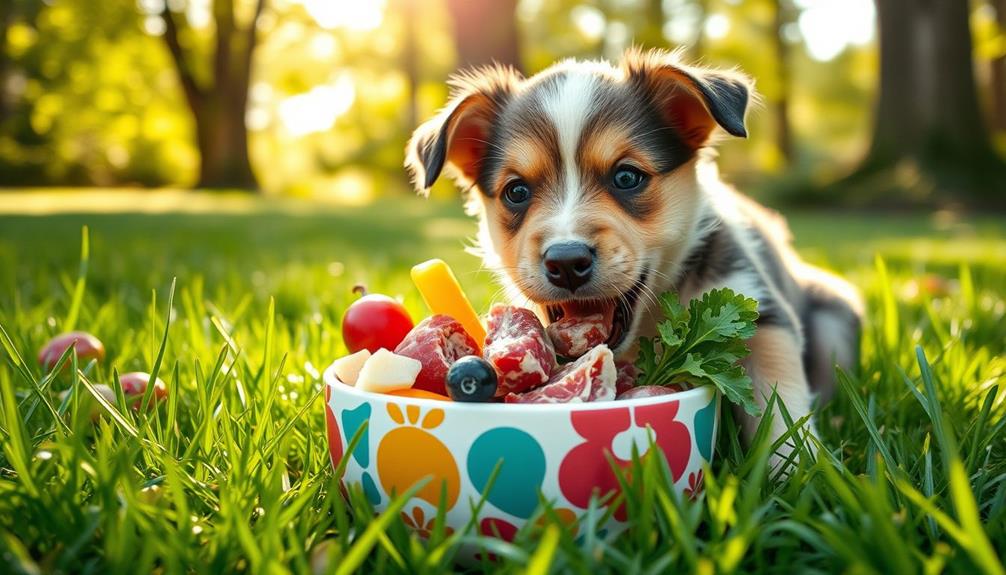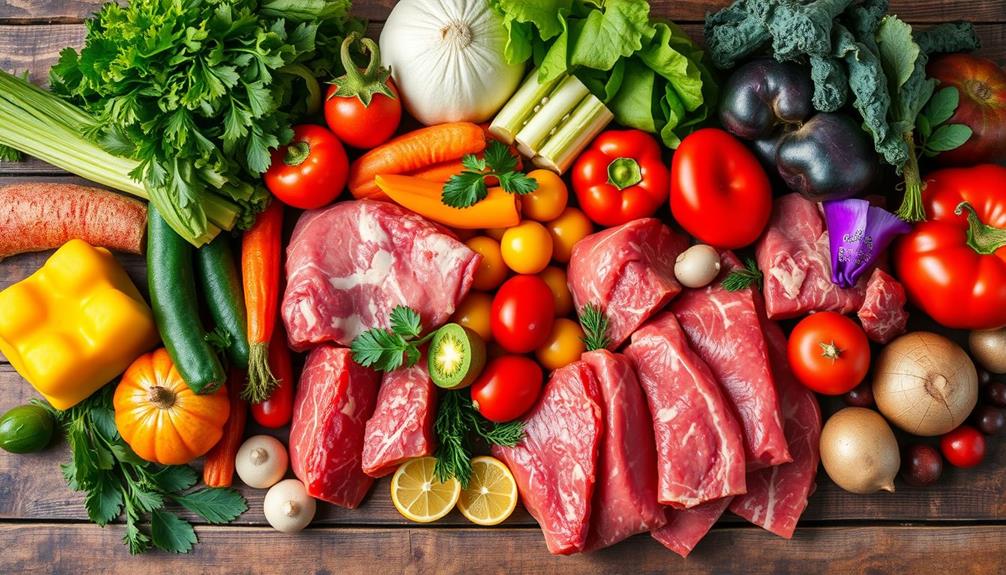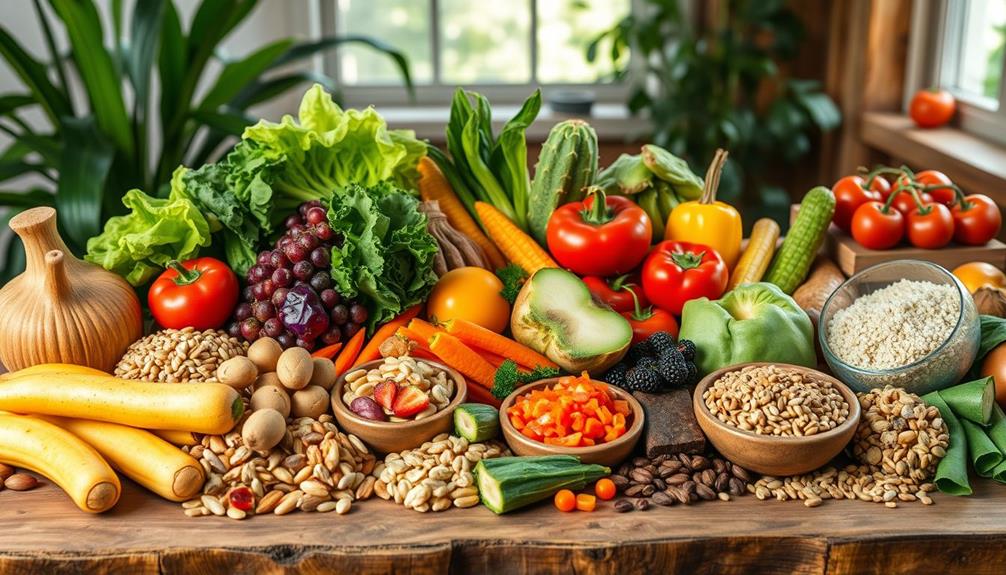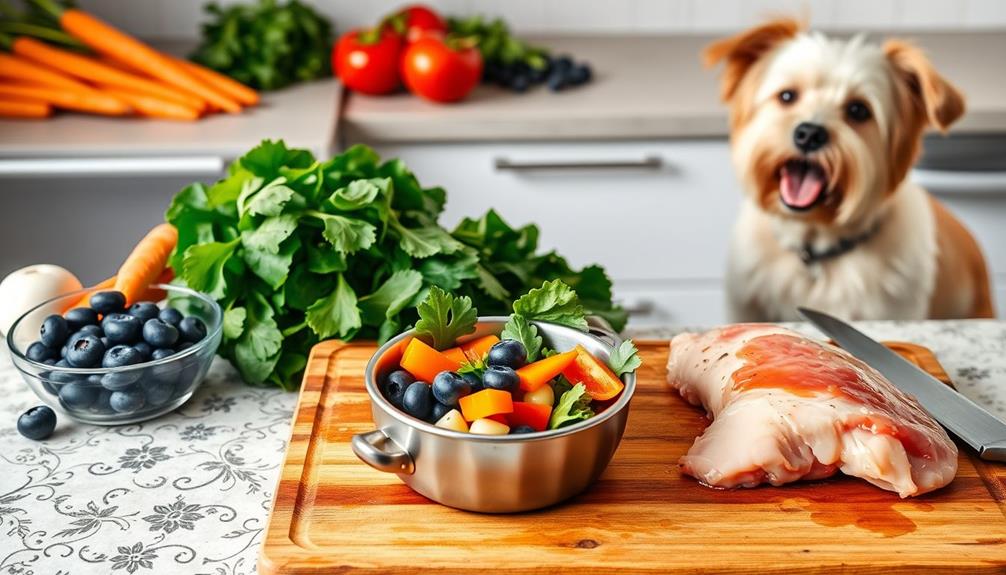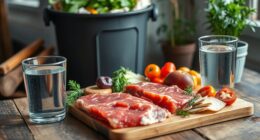When choosing raw food for your puppy, aim for a balanced mix of high-quality muscle meat, meaty bones, and organ meats. Muscle meat should make up 70-80% of the diet, ensuring essential amino acids. Meaty bones provide calcium and phosphorus while organ meats offer essential vitamins and minerals. It's important to source fresh ingredients and maintain a proper calcium-to-phosphorus ratio for healthy bone development. Gradually introduce new proteins to prevent digestive issues. With the right combinations, you'll enhance your puppy's health and well-being. Stick around to explore more options and tips for a thriving raw food diet.
Key Takeaways
- A balanced raw diet for puppies should consist of 70%-80% muscle meat for essential amino acids and high-quality protein.
- Incorporate 10%-15% meaty bones for calcium and phosphorus, essential for bone development.
- Include 10%-15% organ meats to provide vital vitamins and minerals; introduce them gradually to avoid digestive issues.
- Offer a variety of protein sources, such as beef, chicken, and fish, to prevent nutritional deficiencies and promote dietary diversity.
- Ensure high-quality meat from reputable suppliers to minimize pathogen risks and maintain overall health.
Nutritional Needs of Puppies
Puppies are like sponges, absorbing everything they need to grow strong and healthy. To support their rapid growth and high energy levels, you need to provide a calorie-appropriate diet that consists of 4%-10% of their body weight daily.
A balanced diet for puppies should focus on high protein content, ideally from fresh muscle meat, to deliver essential amino acids necessary for developing muscles, skin, and coat. Additionally, incorporating a variety of fruits and vegetables can provide essential vitamins and minerals, as some options are rich in nutritional benefits that support overall health.
Don't forget that proper calcium and phosphorus levels are vital for bone development. Aim for a calcium-to-phosphorus ratio of approximately 1.4:1 to guarantee your puppy's bones grow strong.
Nutritional balance goes beyond just proteins and fats; it should also include carbohydrates, vitamins, and minerals to promote healthy overall growth and development.
Digestibility is essential for puppies, as their developing digestive systems are sensitive. Raw food diets that incorporate easily digestible ingredients can help prevent stomach issues.
Types of Raw Diets
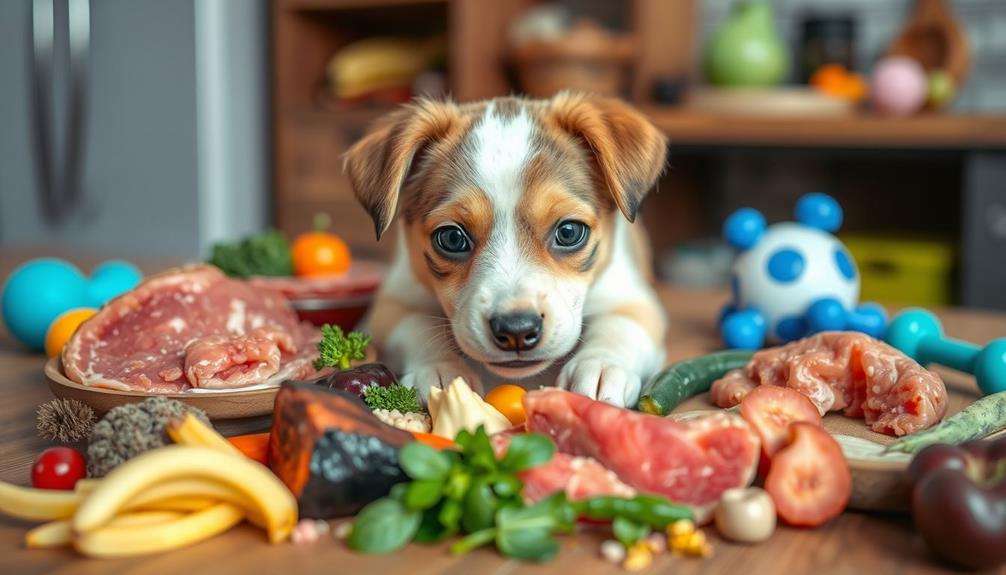
When choosing a raw diet for your puppy, you'll encounter various options that include raw meat selections, balanced ingredient combinations, and supplementary nutritional additions. One popular option for a raw diet for puppies is to offer a combination of raw meats, bones, and organs to mimic a more natural diet. This can provide essential nutrients and help support your puppy’s overall health. Some owners also choose to add raw vegetables and fruits to their puppy’s diet to provide additional vitamins and minerals. Overall, the raw food benefits for puppies include improved digestion, healthier skin and coat, and increased energy levels.
High-quality protein sources, such as those found in healthy dog snacks, play an essential role in meeting your puppy's specific dietary needs.
Each type plays an important role in meeting your puppy's specific dietary needs. Understanding these categories helps you create a well-rounded meal plan that supports healthy growth and development.
Raw Meat Options
Choosing the right raw meat options for your puppy is crucial for their growth and health. A balanced raw diet consists of various components to guarantee your puppy gets all the nutrients they need. Here's a quick overview of what to include in their meals:
| Component | Percentage of Diet |
|---|---|
| Muscle Meat | 35%-50% |
| Meaty Bones | 50%-66% |
| Organ Meats | 10%-25% |
| Protein Sources | Varies |
Muscle meat should make up a significant portion of their diet to provide essential amino acids. Meaty bones, like turkey necks and chicken backs, are crucial as they supply necessary calcium and phosphorus for healthy bone development. Organ meats are nutrient-dense and should be introduced gradually to avoid digestive upset. After the first week, you can start incorporating a variety of protein sources, such as beef, chicken, and fish, to promote dietary diversity. Always source your raw meat options from reputable suppliers to minimize the risk of pathogens and nutritional imbalances in your puppy's diet.
Balanced Ingredient Combinations
A balanced raw diet incorporates a variety of ingredients to guarantee your puppy receives all the necessary nutrients for healthy growth.
To achieve this nutritional balance, focus on these key components:
- Muscle meat (70-80%): This should be the primary ingredient, providing essential amino acids. It's important to make sure the meat is fresh and of high quality, similar to the considerations found in hamster care and costs.
- Meaty bones (10-15%): These are essential for supplying calcium and phosphorus, critical for developing strong bones.
- Organ meats (10-15%): Rich in vitamins and minerals, organ meats play a significant role in your puppy's overall health.
- Variety of protein sources: Incorporate chicken, beef, turkey, and fish to prevent nutritional deficiencies.
Supplementary Nutritional Additions
Supplementary nutritional additions play an essential role in enhancing the quality of a raw diet for puppies. These additions, like probiotics, can boost digestive health and support your puppy's immune system, making them a must-have in their diet.
Incorporating digestive enzymes can also greatly improve nutrient absorption from the food, ensuring your puppy gets the most out of their meals. Additionally, consider incorporating beneficial elements such as essential oils, which can provide various health benefits, including essential oils for respiratory health and immune support.
Don't overlook the importance of organ meats; while they're nutrient-dense, they should only make up 10%-25% of your puppy's total diet to prevent digestive upset. Introduce them gradually to avoid any issues.
Additionally, consider adding phytoplankton and nutritional herbs like alfalfa and dandelion, which can enhance overall health with their extensive nutrient profiles.
Essential supplements, such as fish oil, are beneficial too. They provide omega-3 and omega-6 fatty acids, promoting a shiny coat and improved intestinal health.
Safe Preparation Methods
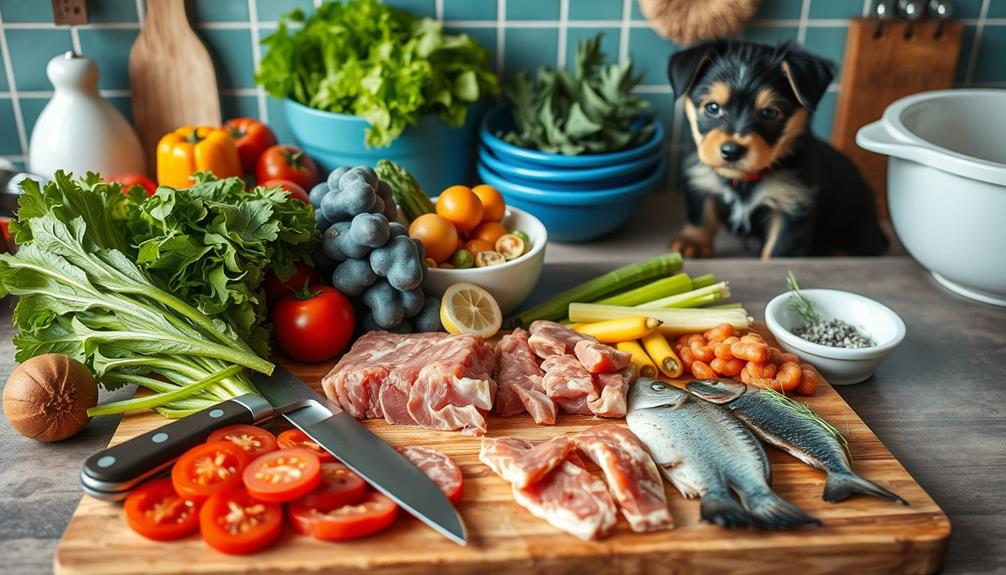
Preparing raw food for puppies requires careful attention to safety and hygiene. Following safe preparation methods is vital to minimize the risk of harmful bacteria that can thrive in raw diets.
Regularly cleaning surfaces and utensils is as important as maintaining air quality in your home to guarantee a safe environment for your puppy. Here are four essential steps to guarantee your puppy's food is safe:
- Use High-Quality Ingredients: Always choose fresh, high-quality meats from reputable suppliers. This minimizes the risk of contamination.
- Handle Raw Meat Carefully: When handling raw meat, be diligent about thorough cleaning. Clean all surfaces, utensils, and your hands immediately after contact to prevent the spread of harmful bacteria like Salmonella and E. coli.
- Freeze Raw Meat: To kill potential parasites, freeze raw meat at appropriate temperatures for at least 3-4 days before thawing it safely in the refrigerator.
- Safe Thawing Methods: Avoid thawing raw food at room temperature. Instead, use safe methods like placing it in the refrigerator or submerging it in cold water to maintain food safety and nutrient integrity.
Feeding Guidelines for Puppies
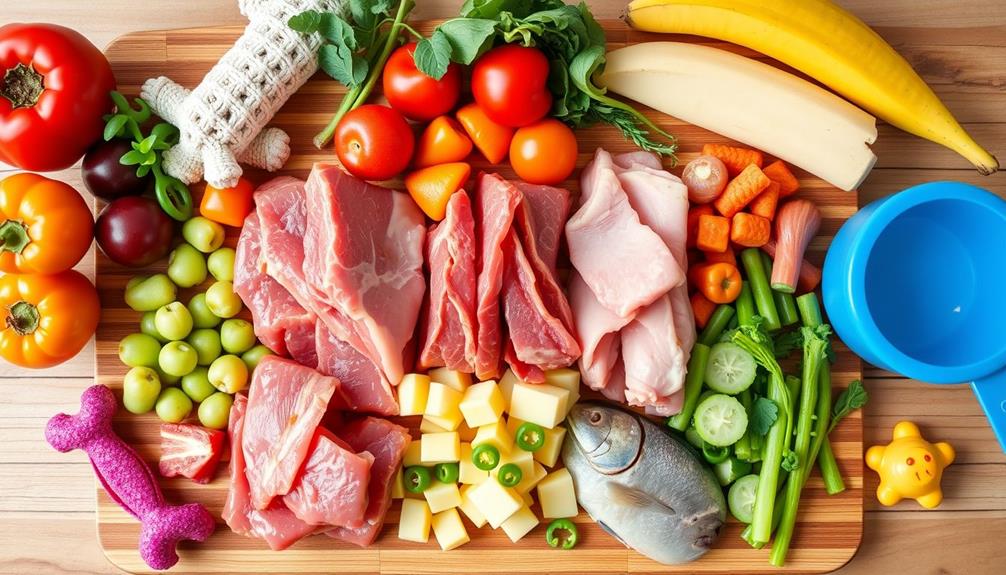
How do you guarantee your puppy gets the right nutrition? Start by following proper feeding guidelines that cater to their age and weight. For puppies, you should feed them 4-10% of their body weight daily, which aligns with the importance of budgeting for your pet's nutrition.
Younger puppies, like an 8-week-old, need about 10%, while a 6-month-old only requires around 4%. It's vital to track your puppy's growth and adjust feeding amounts accordingly, similar to how you'd assess your budget monthly to adjust for changes in income or expenses.
Feeding frequency also plays an important role. Initially, offer four meals a day for puppies aged 8 to 16 weeks. As they grow, shift to three meals from 16 weeks to 12 months, and eventually settle on two meals per day.
Keep an eye on your puppy's weight weekly and adjust their food intake as needed. The recommended daily intake of raw food is 2-5% of their expected adult body weight, beginning with estimates around 10% of their current weight.
When introducing new protein sources, stick to one type for the first week to check for any digestive issues before adding variety.
Benefits of Raw Feeding

When you choose raw feeding for your puppy, you'll likely notice an immediate improvement in their coat quality, making it shinier and healthier within just a few weeks.
This diet can also provide essential nutrients that are essential for their development and immune system, enhancing their overall health.
Plus, this diet enhances digestive health, leading to smaller, firmer stools and less gas.
Improved Coat Quality
Many pet owners notice a remarkable transformation in their puppies' coats after switching to a raw food diet. Within just 2-3 weeks, you may see a glossier and healthier appearance.
This improvement in coat quality can be attributed to several key factors, including the significance of selecting the right nutrients for overall health and wellness, as highlighted in cold medications overview.
- Essential Fatty Acids: Raw dog food rich in omega-3 and omega-6 from meats and fish enhances coat condition and alleviates skin irritations.
- Natural Nutrients: A balanced raw diet promotes the intake of natural nutrients that support skin health, resulting in softer and more resilient fur.
- Reduced Nutritional Deficiencies: Common deficiencies found in processed diets, like vitamin E, are less likely with raw feeding, further boosting coat quality.
- Better Nutrient Absorption: The natural digestibility of raw ingredients allows for improved nutrient absorption, which directly contributes to healthier coats and overall well-being in your puppy.
Enhanced Digestive Health
A raw food diet not only enhances coat quality but also markedly boosts your puppy's digestive health. By opting for a raw dog food diet, you're providing natural ingredients that are easier to digest than processed foods. This leads to improved nutrient absorption, resulting in healthier puppies fed raw.
Here's a quick overview of the digestive benefits:
| Benefit | Explanation |
|---|---|
| Efficient Digestion | Puppies often have smaller, firmer stools, indicating better digestion. |
| Balanced Microbiome | Fresh proteins and enzymes support ideal gut health. |
| Reduced Food Allergies | Minimally processed ingredients lower the chance of sensitivities. |
| Less Digestive Upset | Puppies typically experience reduced flatulence and discomfort. |
These factors contribute to enhanced digestive health, allowing your puppy to thrive. With a balanced microbiome and fewer gastrointestinal issues, you'll notice your puppy feeling more comfortable and energetic. By choosing a raw diet, you're ensuring the best possible nutritional foundation for your furry friend.
Monitoring Puppy Health
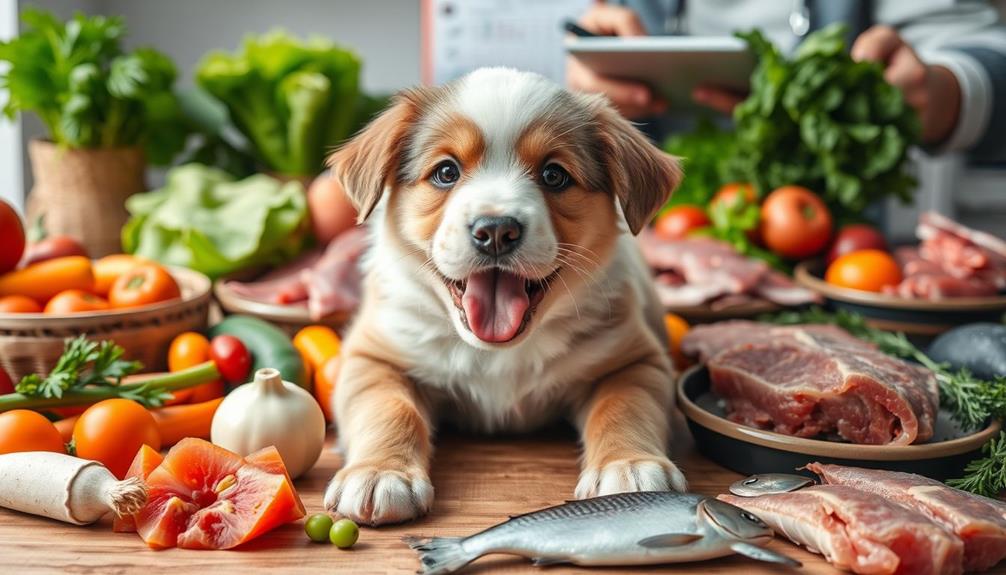
Monitoring your puppy's health is essential for guaranteeing they thrive on a raw food diet. By keeping a close eye on various health indicators, you can make necessary adjustments to their nutrition and overall well-being. Engaging in activities that promote play and exploration, like role-play toy sets, can also support your puppy's development and well-being.
Here are four key areas to focus on:
- Body Condition Score: Regularly assess your puppy's body condition to confirm they've a defined waist and visible ribs. This indicates proper nutrition and weight management.
- Coat Quality: Monitor your puppy's coat. A shiny, healthy coat is a sign of balanced nutrition and overall health. If you notice dullness or shedding, it may signal dietary deficiencies.
- Weight Tracking: Keep track of your puppy's weight weekly. This helps you adjust their food intake based on growth and activity levels, guaranteeing proper weight management.
- Digestive Health: Watch for signs of digestive upset, like diarrhea or vomiting. These may indicate issues with their raw diet, requiring prompt adjustments.
Lastly, don't forget to consult with your vet regularly. They can evaluate your puppy's health and guarantee their nutritional needs are being met, addressing any concerns as they arise.
Common Nutritional Deficiencies

When feeding your puppy a raw diet, it's vital to guarantee they get all the essential nutrients needed for healthy growth.
Common deficiencies, like vitamin E, zinc, and iodine, can impact their immune function and overall well-being.
Understanding financial factors related to pet care can also help in planning for their nutritional needs.
You might need to take into account supplementation to fill these nutritional gaps and keep your puppy thriving.
Essential Nutrients Overview
Maneuvering the world of raw diets for puppies can be challenging, especially when it comes to making certain they get all the essential nutrients they need. Common nutritional deficiencies can arise if you're not careful, affecting your puppy's health and growth.
It's essential to remember that just like with piercing care and hygiene, maintaining a balanced diet involves regular monitoring and adjustments to prevent deficiencies. Here are some key nutrients to focus on:
- Vitamin E – Important for immune function and skin health.
- Zinc – Essential for skin integrity and overall growth.
- Iodine – Significant for metabolic regulation and thyroid function.
- Calcium to Phosphorus Ratio – A balanced ratio of about 1.4:1 is crucial for bone development.
A well-formulated raw diet must include a variety of proteins and organ meats to provide these essential vitamins and minerals. If you rely too heavily on one type of food, you risk creating imbalances that lead to nutritional deficiencies.
Since most of your puppy's calcium and phosphorus come from bones, incorporating raw meaty bones is critical. Regularly consulting with a veterinarian or pet nutritionist guarantees that you're meeting your puppy's specific needs for balanced nutrition, keeping them healthy and vibrant as they grow.
Supplementation Necessities
Even with a well-formulated raw diet, puppies can still face nutritional deficiencies that may require supplementation. Common deficiencies include vitamin E, zinc, and iodine, all important for your puppy's health.
Vitamin E is essential for a strong immune system and helps reduce inflammation, which is particularly significant as your dog ages. Without adequate vitamin E, your puppy might struggle with immune function.
Zinc, another essential nutrient, supports skin health and the immune system. A lack of zinc can lead to skin issues and a weakened immune response, making your puppy more susceptible to infections.
Iodine is crucial for thyroid function, and deficiencies can lead to serious growth and developmental issues. Ensuring your puppy's diet includes iodine-rich foods or appropriate supplements is necessary for healthy development.
To determine the right supplementation for your puppy, it's best to consult with a veterinarian or a pet nutritionist. They can help assess your puppy's specific dietary needs and health status, ensuring you provide the best nutrition necessary for a thriving, healthy pup.
Food Safety Considerations
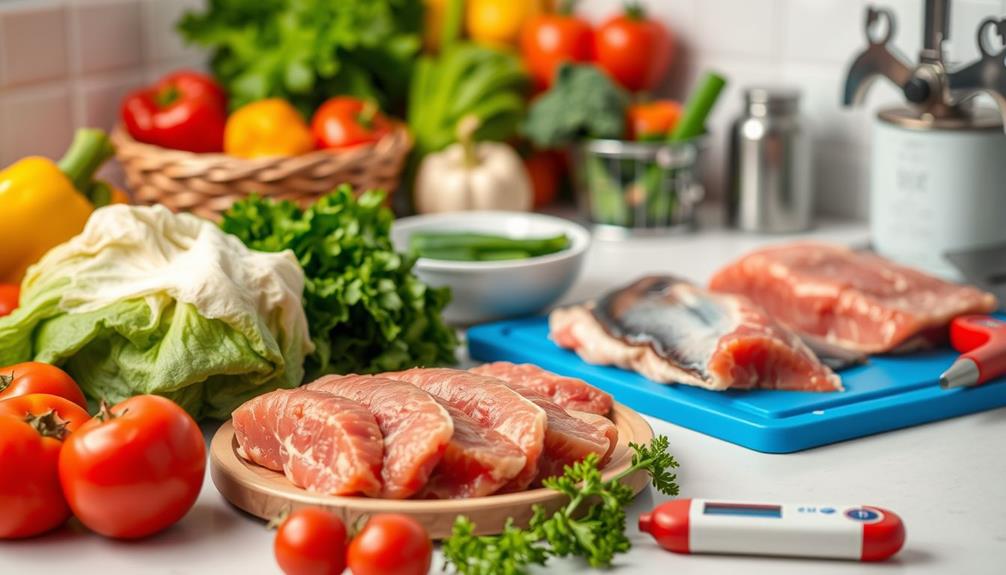
Ensuring food safety is essential for maintaining your puppy's health, especially when feeding a raw diet.
Raw pet food can harbor harmful bacteria like Salmonella and E. coli, so you need to take precautions seriously.
Follow these food safety guidelines to minimize health risks:
- Thawing Process: Always thaw frozen raw meat in the refrigerator. Thawing at room temperature can encourage bacterial growth.
- Cleaning Surfaces: Clean all surfaces and utensils thoroughly after handling raw meat to reduce bacterial contamination.
- Freezing Meat: Freeze raw meat at the recommended temperatures for the specified duration to kill parasites without losing nutrients.
- Consulting with a Veterinarian: Always consult with a veterinarian before starting a raw diet. They can help you understand the potential health risks, including zoonotic diseases like toxoplasmosis.
Veterinary Insights on Raw Diets
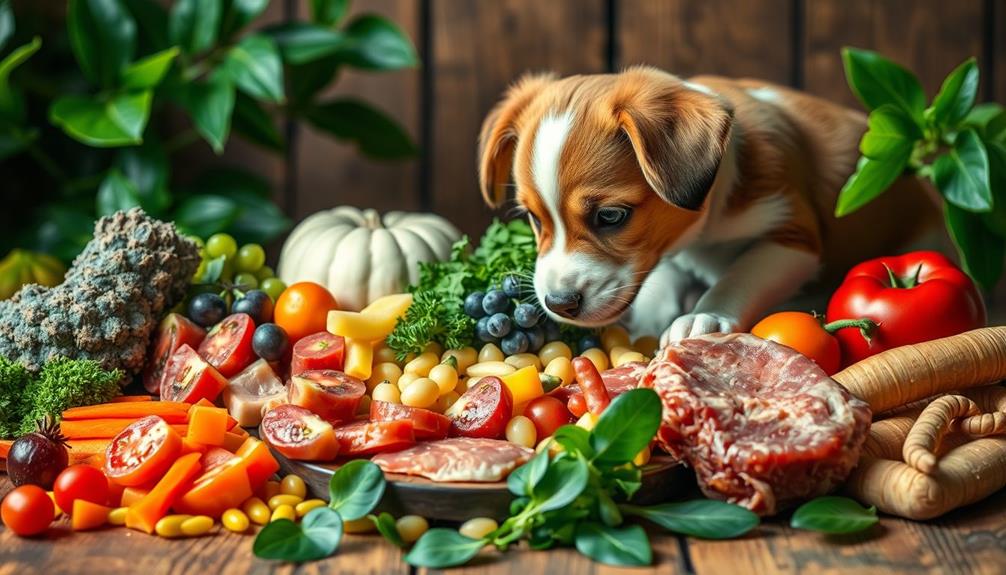
When considering a raw diet for your puppy, it's crucial to weigh the insights provided by veterinarians. Major veterinary associations, including the American Veterinary Medical Association, caution against raw diets due to potential health risks and a lack of scientific evidence supporting their benefits.
Research highlights that without careful balancing, raw diets can lead to nutritional imbalances, resulting in deficiencies of vital vitamins and minerals like vitamin E, zinc, and iodine.
Veterinary insights emphasize the importance of professional consultation before making any dietary changes. Many commercial raw diets have been found contaminated with pathogens, with alarming rates of E. coli and Salmonella detected. This not only poses risks to your pet but can also affect human health.
Additionally, while the idea of homemade raw diets may seem appealing, they often lack scientific oversight, increasing the risk of health issues for your dog if not properly balanced.
Educating yourself on these aspects is critical. By consulting with a veterinarian, you can verify that any raw diet you consider is nutritionally sound and safe, ultimately promoting your puppy's long-term health.
Cost of Raw Feeding Options
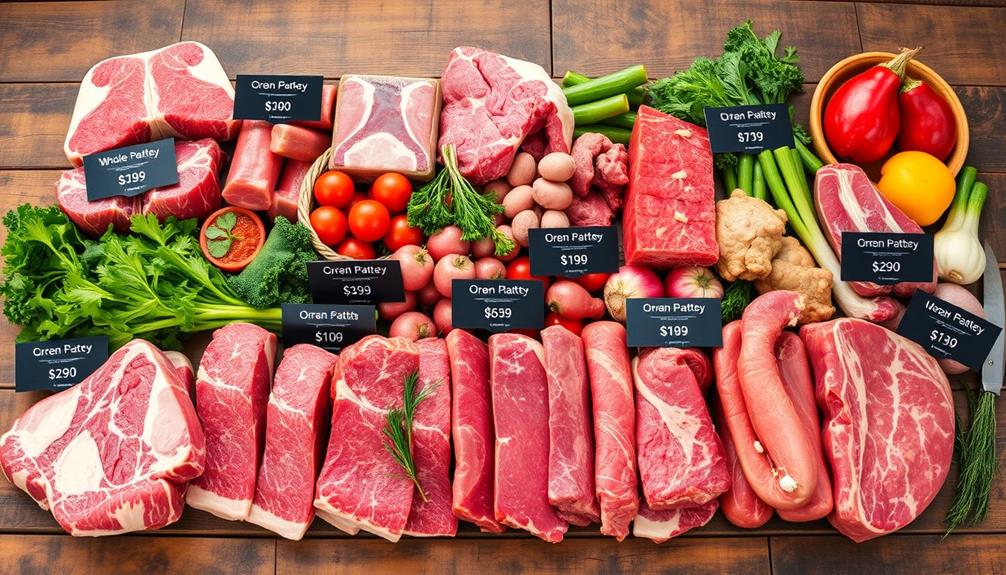
Considering a raw diet for your puppy means not only understanding the potential health implications but also the financial aspects involved. The cost of raw feeding can differ greatly based on factors like puppy size and dietary needs. Here's a breakdown of what to expect:
- Monthly Expenses: Typically, you'll spend between $100 to $300, depending on the quality of ingredients.
- Bulk Buying: Purchasing in bulk from local butchers can greatly cut costs, making it more affordable to feed your puppy raw.
- Subscription Services: These can offer convenience and savings, ensuring you have a steady supply of food without the hassle of frequent shopping.
- Custom Meal Plans: Tailoring meals to your puppy's specific needs can help manage expenses while providing the right nutrition.
Planning meals in advance and taking advantage of seasonal sales can also aid in budget management.
Frequently Asked Questions
What Raw Food Should I Start My Puppy On?
Start your puppy on a single protein source like chicken or turkey. This helps you monitor for any digestive issues. Gradually add meaty bones and organ meats to balance their diet while ensuring healthy growth.
What Raw Meat Is Best for Puppies?
When choosing raw meat for your puppy, focus on muscle meats like chicken or beef. Incorporate meaty bones for calcium, and add organ meats gradually for essential nutrients. Always source from reputable suppliers to guarantee safety.
Do Vets Recommend Raw Food for Puppies?
Vets generally don't recommend raw food for puppies due to nutritional imbalances and health risks. It's essential you consult your veterinarian before making any dietary changes to guarantee your puppy gets balanced nutrition.
When to Introduce Raw Food to a Puppy?
Introducing raw food to your puppy can be exciting yet challenging. Start as early as 8 weeks, gradually increasing from 20% to 100% over a week, ensuring their health and digestion stay balanced throughout the change.
Conclusion
To sum up, choosing the right raw food for your puppy can be a rewarding journey. You'll discover a world of nutritious options that not only support their growth but also strengthen your bond. As you explore different diets together, you might find that feeding them raw can lead to unexpected health benefits. Just remember to keep food safety in mind, and you'll be well on your way to raising a happy, healthy pup. Enjoy the adventure!

